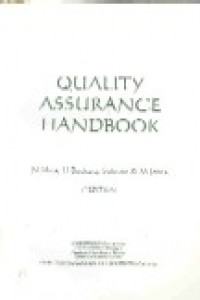
Quality assurance handbook
| Gmd : Text
| Availability :
| 00000001593 | HD62.15 .Q37 2000 | (General Book) | Available - Ada |
| 00000001594 | HD62.15 .Q37 2000 | (General Book) | Available - Ada |
This Quality Assurance Handbook gives a practical step-by-step guide to develop a system of documentation, practices and procedures needed to achieve a desired quality standard such as ISO 9000.
Chapter 2 presents an eight-step process for Quality Assurance. Chapter 3 gives an example of this process to show how easily 'these instructions can be followed. Carrying out these steps is only the first of several actions required to achieve the quality standard. By following these eight steps, you will identify areas where a system of documentation, practices and procedures is required. You then need to establish that system.
A Quality Framework is proposed to help identify the elements of a higher education institution where quality matters. While no framework can be claimed to be fully comprehensive, the one offered incorporates a wide range of academic and administrative areas. Some of the areas are yet to find their way into Indonesian higher education, although they are established elsewhere. Figure 2.1 shows this Quality Framework.
This Handbook uses a Quality Assurance (QA) loop to articulate actions after identifying gaps between what is, and what should be, according to the standard. The main advantage of the loop [Figure 2.2] is that it can be applied to any part of the Quality Framework, and at any level, in a cascading fashion as shown in Figure 2.3. That is, all the steps are the same, irrespective of the level of the framework.
Whilst an institution may use any quality standard, this Handbook provides consistent quality standards for all the elements shown in the Quality Framework. These standards appear in Appendix A in the same order as they appear in the quality framework. These standards are accompanied by their respective Quality Assurance questionnaire. Answers to these questions will indicate whether the institution, faculty or department needs a quality system in that area. If so, then the appropriate unit(s) within that institution will need to develop that system following the steps above.
The subjects of Quality, Quality Assurance, and Total Quality Management are still evolving. Their use in less traditional areas of services, while gaining some popularity, is also bringing forth exciting development. The emphasis on people, for example, is clearly brought out in the elements of the EFQM model and the yet to be released ISO 9000-2000. As a result, a Handbook such as this is also subject to future development and must be used with this in mind.
| Series Title |
-
|
|---|---|
| Call Number |
HD62.15 .Q37 2000
|
| Publisher Place | Jakarta |
| Collation |
ix, 196p.: il.; 20cm.
|
| Language |
English
|
| ISBN/ISSN |
-
|
| Classification |
HD62.15
|
| Media Type |
-
|
|---|---|
| Carrier Type |
-
|
| Edition |
3rd ed.
|
| Subject(s) | |
| Specific Info |
-
|
| Statement |
-
|
| Content Type |
-
|
No other version available







